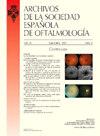平均角膜度数大于 46 度的患者人工晶体计算公式的准确性。
Q3 Medicine
Archivos De La Sociedad Espanola De Oftalmologia
Pub Date : 2024-10-01
DOI:10.1016/j.oftal.2024.05.004
引用次数: 0
摘要
方法对平均角膜屈光度大于 46 D 的 101 名患者的 101 只眼睛进行回顾性分析,获得每位患者术后一个月的绝对预测误差 (EA)。计算所分析的每种公式的平均绝对预测误差 (MEA)、中位数绝对预测误差 (MedEA) 以及绝对屈光误差小于 0.25 D、0.50 D 和 1.00 D 的患者比例。53±0.43)和最低的 MedEA(0.41),其次是 Barrett Universal II(MEA:0.56±0.42,MedEA:0.49)、SRK-T(MEA:0.59±0.44,MedEA:0.54)和 Haigis(MEA:0.77±0.47,MedEA:0.69),结果显示差异显著。还观察到凯恩公式最准确,EA 小于 0.25 D、0.50 D 和 1.00 D 的患者比例最高(分别为 30.7%、54.4% 和 86.1%),而海吉斯公式最不准确(分别为 12.9%、33.7% 和 69.3%)。结论在角膜平均角膜曲率大于 46 D 的眼睛中,Kane 公式被证明是眼内晶状体 (IOL) 功率计算的有用工具,与 Barrett Universal II、SRK-T 和 Haigis 公式相比具有更高的精确度。本文章由计算机程序翻译,如有差异,请以英文原文为准。
Precisión de fórmulas para cálculo de LIO en pacientes con queratometrías promedio mayores de 46 dioptrías
Objective
To compare the accuracy of Kane, Barrett Universal II, Haigis, and SRK-T formulas in eyes with average keratometry greater than 46 diopters (D).
Methods
A retrospective analysis was conducted on 101 eyes of 101 patients with average keratometry greater than 46 D. The absolute prediction error (EA) was obtained for each patient one month after surgery. The mean absolute prediction error (MEA), median absolute prediction error (MedEA) and the percentage of patients with absolute refractive error less than 0.25 D, 0.50 D, and 1.00 D were calculated for each formula analyzed.
Results
The Kane formula achieved the lowest MEA (0.53 ± 0.43) and the lowest MedEA (0.41), followed by Barrett Universal II (MEA: 0.56 ± 0.42, MedEA: 0.49), SRK-T (MEA: 0.59 ± 0.44, MedEA: 0.54), and Haigis (MEA: 0.77 ± 0.47, MedEA: 0.69), showing a significant difference in the results. It was also observed that the Kane formula was the most accurate, with the highest percentage of patients, with EA less than 0.25 D, 0.50 D, and 1.00 D (30.7%, 54.4%, and 86.1%, respectively), while the Haigis formula was the least accurate (12.9%, 33.7%, and 69.3%, respectively).
Conclusion
In eyes with corneas having average keratometry greater than 46 D, the Kane formula proves to be a useful tool in intraocular lens (IOL) power calculation and demonstrates higher precision compared to the Barrett Universal II, SRK-T, and Haigis formulas.
求助全文
通过发布文献求助,成功后即可免费获取论文全文。
去求助
来源期刊

Archivos De La Sociedad Espanola De Oftalmologia
Medicine-Ophthalmology
CiteScore
1.20
自引率
0.00%
发文量
109
审稿时长
78 days
期刊介绍:
La revista Archivos de la Sociedad Española de Oftalmología, editada mensualmente por la propia Sociedad, tiene como objetivo publicar trabajos de investigación básica y clínica como artículos originales; casos clínicos, innovaciones técnicas y correlaciones clinicopatológicas en forma de comunicaciones cortas; editoriales; revisiones; cartas al editor; comentarios de libros; información de eventos; noticias personales y anuncios comerciales, así como trabajos de temas históricos y motivos inconográficos relacionados con la Oftalmología. El título abreviado es Arch Soc Esp Oftalmol, y debe ser utilizado en bibliografías, notas a pie de página y referencias bibliográficas.
 求助内容:
求助内容: 应助结果提醒方式:
应助结果提醒方式:


